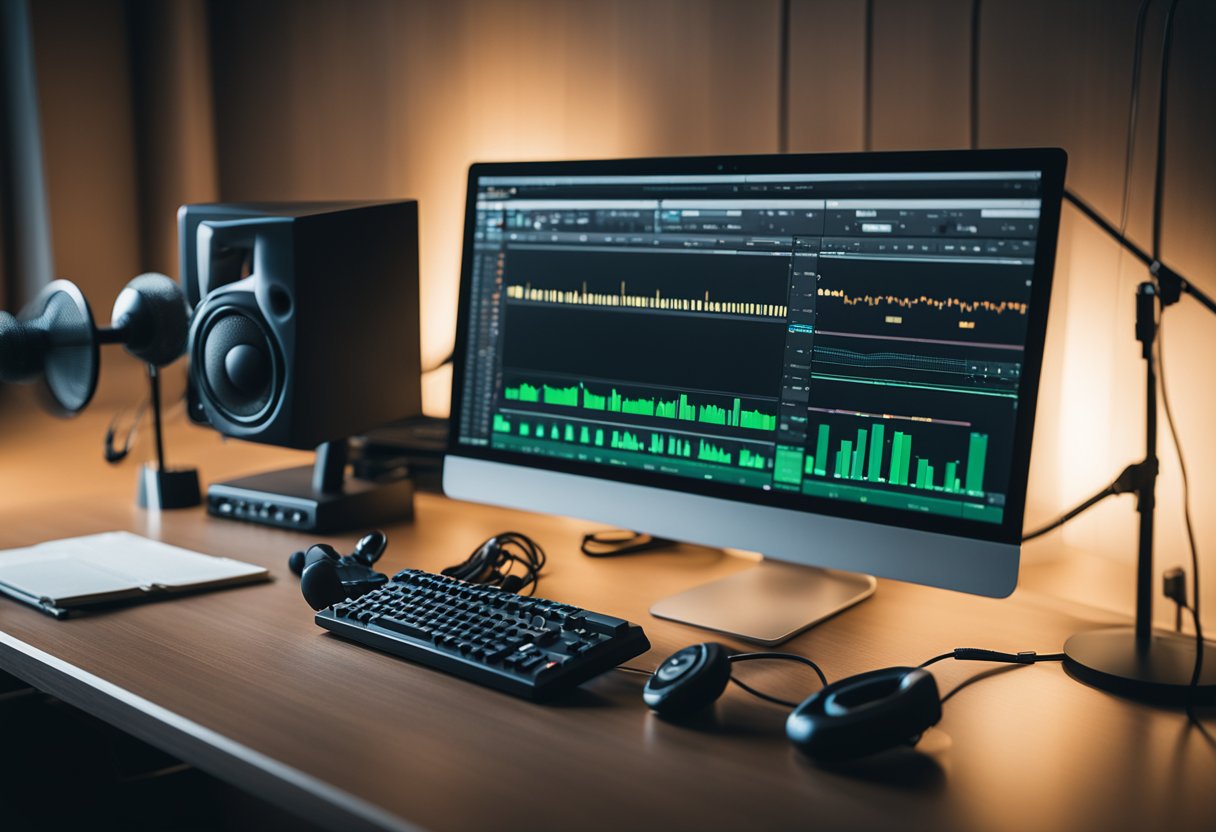Audio plugin development is an essential aspect of music production, as it allows producers and engineers to create custom software that enhances their workflow and creativity. Audio plugins are software components that can be integrated into digital audio workstations (DAWs) to provide additional functionality, such as effects processing, virtual instruments, and audio analysis tools. Developing audio plugins requires a combination of technical skills, creative vision, and attention to detail, making it a challenging but rewarding field.

Understanding audio plugins is the first step towards developing them. Audio plugins are essentially small software programs that can be loaded into a DAW to provide additional functionality. They can be designed to perform a wide range of tasks, from basic audio processing to complex algorithmic synthesis. To develop audio plugins, one must have a solid understanding of digital signal processing (DSP), programming languages, and software development tools.
Setting up the development environment is also an essential part of audio plugin development. This involves configuring the necessary software and hardware components to create, test, and deploy audio plugins. A typical development environment for audio plugins includes a computer with a suitable operating system, a DAW, a plugin development framework, and a set of audio programming tools. Once the development environment is set up, the developer can start designing and programming audio plugins.
Key Takeaways
- Audio plugins are software components that can be integrated into DAWs to provide additional functionality.
- Developing audio plugins requires a combination of technical skills, creative vision, and attention to detail.
- To develop audio plugins, one must have a solid understanding of DSP, programming languages, and software development tools.
Understanding Audio Plugins
Types of Audio Plugins
Audio plugins are software components that can be added to digital audio workstations (DAWs) or standalone audio software to enhance their functionality. There are several types of audio plugins available, each designed to perform a specific task. Some of the common types of audio plugins include:
- Effects Plugins: These plugins are used to add or modify audio effects such as reverb, delay, chorus, and distortion to audio signals.
- Virtual Instruments Plugins: These plugins are used to create and manipulate virtual instruments such as synthesizers, samplers, and drum machines.
- Utility Plugins: These plugins are used to perform utility tasks such as gain control, EQ, and compression.
How Audio Plugins Work
Audio plugins work by processing digital audio signals in real-time. When an audio signal is passed through a plugin, the plugin modifies the signal according to its programming and returns the modified signal to the DAW or audio software. The modified signal can then be further processed or mixed with other audio signals.
Plugins can be programmed using a variety of programming languages such as C++, Java, and Python. They can also be developed using specialized software development kits (SDKs) provided by DAW and audio software manufacturers.
Common Audio Plugin Formats
There are several common audio plugin formats available, each with its own advantages and disadvantages. Some of the common audio plugin formats include:
- VST: Developed by Steinberg, VST is the most widely used audio plugin format. It is available for both Mac and Windows and is supported by most DAW and audio software.
- AU: Developed by Apple, AU is the audio plugin format used by Logic Pro X and GarageBand. It is only available for Mac.
- AAX: Developed by Avid, AAX is the audio plugin format used by Pro Tools. It is available for both Mac and Windows.
Plugins can also be developed using web technologies such as HTML, CSS, and JavaScript. These plugins are called web audio plugins and can be used in web-based audio software.
Setting Up the Development Environment

Choosing the Right Tools and Frameworks
Developing audio plugins requires a specific set of tools and frameworks. The choice of tools and frameworks depends on the type of plugin being developed and the developer’s preference. Some popular frameworks include JUCE, VST SDK, and Audio Units SDK. These frameworks provide a set of tools that simplify the plugin development process.
Installation and Configuration
Once the developer has chosen the appropriate framework, the next step is to install and configure the development environment. The installation process is straightforward and involves downloading the framework from the official website and following the installation instructions. Configuration involves setting up the development environment to ensure that it integrates with the chosen framework. This includes configuring the IDE, setting up the build system, and configuring the framework’s settings.
Testing and Debugging Tools
Testing and debugging are crucial steps in the development process. To ensure that the plugin works as intended, the developer must test it thoroughly. This involves using testing tools such as unit testing frameworks and audio analysis tools. Debugging tools such as debuggers and loggers are also essential in identifying and fixing bugs in the code.
In conclusion, setting up the development environment for audio plugin development requires choosing the right tools and frameworks, installing and configuring the development environment, and using testing and debugging tools. By following these steps, developers can create high-quality audio plugins that meet the needs of music producers.
Designing Audio Plugins

Audio plugins are an essential part of the music production process, allowing musicians and producers to manipulate sound in a variety of ways. Designing audio plugins requires a combination of knowledge in software development, digital signal processing, and user interface design. In this section, we will explore the key aspects of designing audio plugins, including user interface design, audio processing algorithms, and parameter management.
User Interface Design
The user interface of an audio plugin is the first point of contact between the user and the plugin. It is crucial to design an interface that is intuitive, easy to navigate, and visually appealing. The interface should provide all the necessary controls and feedback for the user to achieve their desired sound.
A well-designed user interface should be consistent with other plugins and digital audio workstations (DAWs), making it easy for the user to understand and operate. The use of color, typography, and iconography can help to differentiate between different controls and functions.
Audio Processing Algorithms
The audio processing algorithms used in an audio plugin are responsible for manipulating the audio signal. These algorithms can range from simple filters to complex spectral analysis and synthesis techniques. It is essential to choose the appropriate algorithm for the desired effect, taking into account factors such as latency, CPU usage, and sound quality.
The implementation of audio processing algorithms requires knowledge of digital signal processing (DSP) techniques and programming languages such as C++ or Python. It is crucial to optimize the code to minimize latency and CPU usage while maintaining sound quality.
Parameter Management
Audio plugins typically have a large number of parameters that can be adjusted by the user. These parameters can include values such as gain, frequency, and resonance. It is essential to design a system for managing these parameters that is consistent, intuitive, and easy to use.
One approach to parameter management is to group related parameters together and provide a visual representation of their values. This can be achieved through the use of sliders, knobs, or other graphical controls. It is also essential to provide feedback to the user, such as visual or audible cues, when a parameter is adjusted.
In conclusion, designing audio plugins requires a combination of knowledge in software development, digital signal processing, and user interface design. A well-designed plugin should have an intuitive and visually appealing user interface, appropriate audio processing algorithms, and a system for managing parameters that is easy to use.
Programming Audio Plugins

Digital Signal Processing Basics
Programming audio plugins requires a solid understanding of digital signal processing (DSP) concepts. This includes knowledge of filters, delays, reverbs, and other effects commonly used in music production. DSP algorithms must be implemented in a way that is efficient and optimized for real-time processing.
Developers must also be familiar with different types of audio signals, such as mono, stereo, and multi-channel audio. They must understand how to manipulate these signals to achieve the desired effect. This may involve applying different processing techniques to different frequency ranges or using techniques such as side-chain compression to create space in a mix.
Implementing Real-Time Audio Processing
Real-time audio processing is critical for audio plugins used in music production. Latency must be minimized to ensure that the processing is in sync with the audio being played. This requires careful optimization of the plugin code and the use of specialized real-time audio processing libraries.
Developers must also be familiar with different plugin formats, such as VST, AU, and AAX. Each format has its own requirements and limitations, and developers must ensure that their plugins are compatible with all major digital audio workstations (DAWs).
Cross-Platform Development Considerations
Cross-platform development is essential for audio plugins, as they must be compatible with both Windows and macOS systems. This requires careful attention to platform-specific issues such as file paths, user interface elements, and audio drivers.
Developers must also be aware of different processor architectures and ensure that their plugins are optimized for both Intel and ARM-based processors. This may involve using different compiler settings or implementing platform-specific optimizations.
Overall, programming audio plugins requires a deep understanding of DSP concepts, real-time processing, and cross-platform development considerations. By mastering these skills, developers can create powerful and efficient plugins that enhance the music production process.
Optimizing Audio Plugin Performance

Memory Management
One of the most important aspects of optimizing audio plugin performance is memory management. Plugins that use a lot of memory can slow down a user’s computer and cause audio glitches. To avoid this, developers should make sure their plugin is only using the memory it needs and releasing memory when it’s no longer needed.
Developers can use tools such as memory profilers to identify memory leaks and other memory-related issues. They can also use techniques such as object pooling to reuse objects instead of creating new ones, which can help reduce memory usage.
CPU Efficiency
Another important factor in optimizing audio plugin performance is CPU efficiency. Plugins that use a lot of CPU can cause audio glitches and slow down a user’s computer. To avoid this, developers should make sure their plugin is only using the CPU it needs and not wasting cycles on unnecessary tasks.
Developers can use techniques such as multithreading to distribute CPU-intensive tasks across multiple cores, which can help reduce the overall CPU usage of the plugin. They can also optimize algorithms and data structures to reduce the number of CPU cycles needed to perform a task.
Latency Issues
Latency is a major concern for audio plugins, as it can cause noticeable delays between a user’s input and the plugin’s output. To avoid latency issues, developers should minimize the amount of processing time needed for their plugin.
Developers can use techniques such as block processing to process audio in larger chunks, which can reduce the overall processing time needed for the plugin. They can also use techniques such as lookahead processing to predict future audio samples and reduce the amount of delay introduced by the plugin.
By focusing on memory management, CPU efficiency, and latency issues, developers can optimize their audio plugins for maximum performance and minimal impact on a user’s computer.



